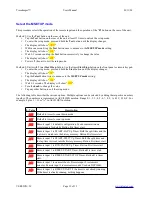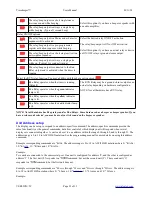
Timekeeper™
Users Manual
01/11/20
Historical data capture
The most recent 16 events are captured and saved into EEPROM. Three types of events are captured:
•
The
timer value
is captured if the unit is in the timer mode. The timer display must be in count up mode. Each
time the count up timer is reset to zero, the value in the display is stored into the history EEPROM memory.
•
The
counter value
is captured if the unit is in the counter mode. Each time the counter is reset, the value in
the display is stored into the history EEPROM memory.
•
The
score value
is captured if the unit is in the score keeper mode. Each time the score is reset, the value in
the display is stored into the history EEPROM memory.
To display the contents of the history memory, press the
History
button. Each press of the
History
button will display
successively older entries in memory. When the end of the history memory is reached, the display will
Show "------". Timer entries will have decimal points every two digits. Counter entries will not have any decimal
points.
Remote Display mode
The remote display mode displays alphanumeric characters received on the serial port.
Alphanumeric character on Seven-Segment LED Displays
Due to the limitations of seven-segment LEDs, certain displays replace some alphabetic characters by a strange
character. Those replaced characters (both upper and lower case) for those types of displays are: m, q and w.
Additionally, the “z” character on those displays appears as two parallel lines “||”, and the “k” character partially
appears “|-”. The remaining characters appear only in their upper or lower case form in order to remain identifiable on
the seven-segment LED displays.
In addition to alphanumeric characters, the seven-segment LED displays are also able to show the dash, space and
period characters (“-”, “ “, “.”). Any other characters not mentioned here may be ignored by the display, potentially
causing the entire message to be ignored.
VERSION=5C
Page 12 of 33













































